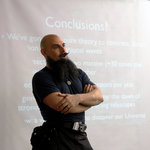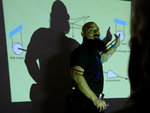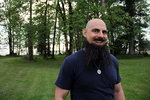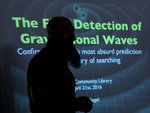



While Bill Nye the Science Guy is rarely, if ever, seen without a bowtie, Toledo theoretical astrophysicist Ethan Siegel prefers his ensembles to include a kilt.
Siegel, 37, said he is often asked why he doesn’t look like a scientist. It’s a question he explored in a blog post earlier this month that discusses the stereotypes of scientists and concludes that intellect doesn’t have anything to do with physical appearance.
More often than answering questions about his wardrobe, Siegel explores questions about the universe, both on his blog and in his recently published book.
While an astronomer studies everything in the universe beyond Earth, an astrophysicist studies the reasons the universe works the way it does and how it began.
Siegel studies the Big Bang Theory and how it pertains to how life has reached the point it has today.
He grew up in New York City, but has lived in a variety of places. After receiving undergraduate degrees in physics and classics, he taught high school before he realized that wasn’t what he wanted to do.
“So I did what a lot of people in that situation do. I had a crisis,” Siegel said, noting it wasn’t a bad experience; it gave him the opportunity to determine what he wanted to do.
He decided he wanted to learn about the history of the universe, what it’s made of and what its future will be, so he went to graduate school at the University of Florida and became a theoretical cosmologist, a subfield of astrophysics.
Siegel estimates there are about 1,000 people in the world who also study theoretical cosmology. With his kilts, he tends to be pretty recognizable in their community, he said.
Before moving to Toledo about 18 months ago, Siegel and his wife had been living in Portland. Siegel taught at the University of Portland. He continues to occasionally teach at Lewis and Clark College.
Siegel currently writes about science professionally. Forbes.com, Medium.com and ScienceBlogs.com host his blog, “Starts With A Bang!”, which he began in 2008. He also published his first book, “Beyond the Galaxy: How Humanity Looked Beyond Our Milky Way and Discovered the Entire Universe,” in December 2015.
“After I finished all my studies … I realized that this was an amazing story that you literally had to get your Ph.D. in theoretical astrophysics to get that full story, and there’s no reason for it to be that way,” Siegel said.
He wanted to make the story accessible to everyone, and that’s what his book aims to do. He said people who are curious and intelligent but don’t have scientific backgrounds can understand the book, which is available on Amazon.
“There are lots of stories in there and there are lots of illustrations in there and there are no equations in there,” Siegel said.
He shared one story about the universe, a recent discovery, with about 30 curious people on Thursday evening at the Toledo Community Library.
Wearing his kilt, Siegel gave a presentation about the September 2015 detection of gravitational waves.
To detect gravitational waves, scientists created LIGO, Laser Interferometer Gravitational-Wave Observatory, an observatory that uses perpendicular lasers that can detect gravitational waves caused by black holes merging, neutron stars merging, black holes and neutrons stars merging together or other activity.
Albert Einstein predicted gravitational waves, which are ripples in the fabric of space-time, in his theory of relativity.
Einstein’s theory said that large objects orbiting one another, such as neutron stars or black holes, would create waves in space that travel at the speed of light.
“Not only was this looked at as crazy, it was looked at as completely untestable,” Siegel told The Chronicle.
In 1974, two astronomers discovered the pulse of two stars orbiting one another. According to Einstein’s theory, the activity should create gravitational waves. Data from measuring the pulses showed the stars were getting nearer to one another at the same rate Einstein predicted.
“But this is an indirect detection,” Siegel said.
The Sept. 14, 2015, detection by LIGO was the first time gravitational waves were sensed. The waves were caused by two colliding black holes 1.3 billion light years away.
“This is really the discovery of a lifetime,” Siegel said.